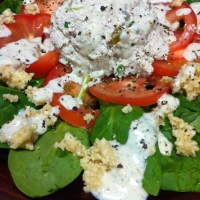Ever wonder about carrageenan on the ingredients list of many vegan foods? Here is a great informational piece from Rachel in Veganland:
-
Join 1,627 other subscribers
Don’t Fear The Vegan
Top Posts & Pages
bloglovin
Don’t Fear The Vegan
Tweets by dontfearvegan-
Recent Posts
Categories
- 12 Days
- 5 Recipes
- A – Z MOFO 2011
- Almost Raw
- An Ode to Vegan Bloggers MOFO 2012
- Anzia's picks-a young vegans perspective
- appetizer
- Arbonne
- Bread
- breakfast
- casserole
- cheesy sauces
- dessert
- dressings/sauces
- Feilipe's Rastaurant Adventures
- Felipe's corner
- Gardein
- German
- Gluten Free
- Guest Post
- holiday
- Interviews
- Italian
- Kid in the Kitchen
- Main Course
- Mexican
- MOFO 2013: Dad Says It's Toxic
- Mom's Recipes
- Poll
- Pro Vegan Images
- Product Review
- Random info
- Raw
- Salad
- Sides
- soup
- Uncategorized
- Vegan MOFO
- Vegan Mofo 2014
- Vegan Motivation
- Vegans Say What?
- video
- Worthy of Sharing
Where in the World?
Archives
My RSS
Posts by Date
We made 3rd. Thanks!!














SO MUCH FOR THE MYTHS
CONSIDER THE FACTS ON CARRAGEENAN FOR A CHANGE
Q. What is Carrageenan??
A. Carrageenan is a naturally-occurring seaweed extract. It is widely used in foods and non-foods to improve texture and stability. Common uses include meat and poultry, dairy products, canned pet food, cosmetics and toothpaste.
Q. Why the controversy?
A. Self-appointed consumer watchdogs have produced numerous web pages filled with words condemning carrageenan as an unsafe food additive for human consumption. However, in 70+ years of carrageenan being used in processed foods, not a single substantiated claim of an acute or chronic disease has been reported as arising from carrageenan consumption. On a more science-based footing, food regulatory agencies in the US, the EU, and in the UN’s Food and Agriculture Organization/World Health Organization (FAO/WHO) repeatedly review and continue to approve carrageenan as a safe food additive.
Q. What has led up to this misrepresentation of the safety of an important food stabilizer, gelling agent and thickener?
A. It clearly has to be attributed to the research of Dr. Joanne Tobacman, an Associate Prof at the University of Illinois in Chicago. She and a group of molecular biologists have accused carrageenan of being a potential inflammatory agent as a conclusion from laboratory experiments with cells of the digestive tract. It requires a lot of unproven assumptions to even suggest that consumption of carrageenan in the human diet causes inflammatory diseases of the digestive tract. The objectivity of the Chicago research is also flawed by the fact that Dr Tobacman has tried to have carrageenan declared an unsafe food additive on weak technical arguments that she broadcast widely a decade before the University of Chicago research began.
Q. What brings poligeenan into a discussion of carrageenan?
A. Poligeenan (“degraded carrageenan” in pre-1988 scientific and regulatory publications) is a possible carcinogen to humans; carrageenan is not. The only relationship between carrageenan and poligeenan is that the former is the starting material to make the latter. Poligeenan is not a component of carrageenan and cannot be produced in the digestive tract from carrageenan-containing foods.
Q. What are the differences between poligeenan and carrageenan?
A. The production process for poligeenan requires treating carrageenan with strong acid at high temp (about that of boiling water) for 6 hours or more. These severe processing conditions convert the long chains of carrageenan to much shorter ones: ten to one hundred times shorter. In scientific terms the molecular weight of poligeenan is 10,000 to 20,000; whereas that of carrageenan is 200,000 to 800,000. Concern has been raised about the amount of material in carrageenan with molecular weight less than 50,000. The actual amount (well under 1%) cannot even be detected accurately with current technology. Certainly it presents no threat to human health.
Q. What is the importance of these molecular weight differences?
A. Poligeenan contains a fraction of material low enough in molecular weight that it can penetrate the walls of the digestive tract and enter the blood stream. The molecular weight of carrageenan is high enough that this penetration is impossible. Animal feeding studies starting in the 1960s have demonstrated that once the low molecular weight fraction of poligeenan enters the blood stream in large enough amounts, pre-cancerous lesions begin to form. These lesions are not observed in animals fed with a food containing carrageenan.
Q. Does carrageenan get absorbed in the digestive track?
A. Carrageenan passes through the digestive system intact, much like food fiber. In fact, carrageenan is a combination of soluble and insoluble nutritional fiber, though its use level in foods is so low as not to be a significant source of fiber in the diet.
Summary
Carrageenan has been proven completely safe for consumption. Poligeenan is not a component of carrageenan.
Closing Remarks
The consumer watchdogs with their blogs and websites would do far more service to consumers by researching their sources and present only what can be substantiated by good science. Unfortunately we are in an era of media frenzy that rewards controversy.
Thanks for sharing this information. I will share.